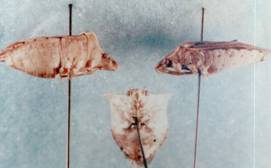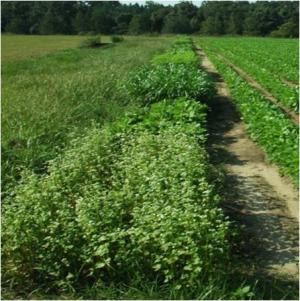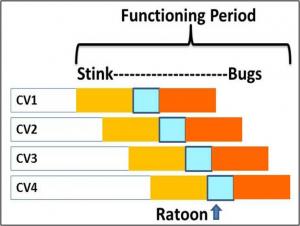eOrganic author:
Russell F. Mizell III, University of Florida
Brown Marmorated Stink Bug
Note that the best plants to use as trap crops for the Brown Marmarated Stink Bug (BMSB) have not been determined to date, but sunflowers, squash, zucchini, and pumpkin appear to have strong merit. Hollyhocks are also used by all stages of the first generation of BMSB, are easy to grow, and may have some merit for use by homeowners to attract and kill BMSB as they leave dwellings where they have overwintered. Growers can follow the Organic Management of Brown Marmorated Stink Bugwebsite for up-to-date research and other information on BMSB, including trap crops.
Introduction
Stink bugs (Pentatomidae) and leaffooted bugs (Coreidae) are currently an overarching issue in agriculture. Stink bugs—mainly the brown, the dusky, the green and the southern green—and the leaffooted bugs have become important primary pests of most fruit, nut, vegetable, and seed crops (Fig. 1). Additional major and minor species also occur throughout the U.S. Another non-native, damaging species, the brown marmarated stink bug (BMSB), is now spreading across the U.S. Stink bugs are extremely polyphagous—they feed on a wide range of plants. They can move over large distances and use a sequence of plants/crops as their populations increase throughout the year. Stink bug seasonal abundance and distribution are driven by food quality and availability. These insects are tolerant of many insecticides and are difficult to suppress. Interestingly, stink bugs also include beneficial preators—these beneficial insects can be distinguished by examining the mouthparts (Fig. 2).
For the reasons discussed above, stink bugs are difficult to manage—especially in organic systems. Initial research suggests that trap cropping may be a useful strategy available to organic producers for managing these troublesome pests, but continued efforts are needed to identify appropriate trap crops and management to use for different stink bug species combinations and crops in different regions of the U.S. This article presents background information and summarizes research results for this potential management tactic. An original paper on stink bug trap cropping by Mizell et al. (2008) should be read by anyone contemplating using these trap crops.

Figure 1. Several major stink and leaffooted bugs in the southern states. (left) green, Chinavia hilaris (formerly Acrosternum hilare) and brown, Euschistus servus; right - leaffooted bug, Leptoglossus phyllopus. Photo credit: R. F. Mizell, III, University of Florida.

Figure 2. To distinguish beneficial predatory stink bugs from plant-feeding pests, examine the way the mouthparts attach to the head. Plant feeder mouthparts are attached tightly without a space (left), while the mouthparts of beneficial species (right) have a space between the head and the mouthparts. Photo credit: R. F. Mizell, III, University of Florida.
Stink Bug Behavior
Stink bugs use a sequence of crops through the season. An intercropping or a companion planting approach will not work for stink bugs, in all instances. Such spatial configurations will provide a pathway for the stinkbugs to spread into the cash crop interior, which is to be avoided. Stink bugs exhibit a very strong "edge effect" behavior when moving through the landscape that results in damage accumulation at crop borders and an increase in damage over time as the stink bugs disperse into the crop's interior. In some situations, stink bugs only damage the border rows and those can be used as the trap crop. Note that BMSBs also manifest this behavior, as evidenced by the border patterns of green non-senescing plants (plants which stay in a juvenile state) seen in soybean fields in fall as a result of BMSB feeding.
Stink bugs respond strongly to vegetation borders and do not like to cross open areas where they are more exposed to natural enemies (they have a short "perceptual range"). Therefore, their movement is usually along the edges of crops, fence rows, wind breaks, and other natural structures.
Producers may want to use an aerial map or photograph (e.g., Google Earth) to analyze and predict how stink bugs would most likely move through crop landscapes and place trap crops in these "transition" pathways accordingly. Organic growers may want to permanently assign such critical areas to trap crops, as well as maintain close attention to the relative location and timing of plots with stink bug pests surrounding cash crops. Avoid planting "nurse" crops that will attract and support stink bugs "before in time" or "next to in space" cash crops that are highly susceptible to stink bugs.
Definition of Trap Cropping
Trap cropping is the strategic placement of a small area of highly competitive plant hosts adjacent to cash crops. The trap crop should have minimum side effects and management difficulties as well as be suitable for combination with other tactics to attract stink bugs. Installing the plantings should be cost effective and applicable for each growing season. Such a bio-based trap cropping system has been developed to manage stink bug pests for any planting season from spring to fall in the southeastern states, but the concepts are applicable over a larger area of the U.S.
Methods
Small plots are established adjacent to the cash crop using standard cultural practices (Fig. 3). Mixtures of host species and continuous management are required to ensure optimum food availability in the trap crop to out-compete the cash crop for stink bug feeding. Optimum quality food for stink bugs often means plants with fruiting bodies in the milk or dough stage. However, stink bugs have hundreds of different hosts with other plant parts that they feed on which may vary by stink bug life stage and species. To be effective, trap crops must intercept the stink bugs before they move into the cash crop.

Figure 3. Trap crop of buckwheat and other test plants near soybeans. Photo credit: R. F. Mizell, III, University of Florida.
Logistics – Some Helpful Information That Will Increase Trap Crop Efficacy
- Stink bug source - origin and direction from outside the cash crop; helps identify the most effective location for trap crops
- Dispersal - movement behavior often results in border aggregations or an "edge effect" in distribution; helps identify the most effective location for trap crops
- Host plant range and phenology (flora diversity), reduce competiton or bug sources
- Plants - costs, culture and management, physical properties
- Detection and monitoring methods for stink bugs; can include with trap crops to increase trap crop efficacy
- Behavioral cues, "push-pull" semiochemicals, traps; can include with trap crops to increase trap crop efficacy
- Bug removal methods - sweep net, vacuum, blower; use to eliminate bugs in trap crops
- Insecticide certification (organic) and efficacy; use to eliminate bugs in trap crops
Recommended Plant Species
Triticale with crimson clover and vetch, sorghum, millet, buckwheat, and sunflower are the main species recommended to attract the native stink bug species found in the Southeastern U.S. Okra and field peas can also be used (summary below). Early spring soil temperatures limit growth of some plant species; however, triticale, crimson clover, and vetches (common and hairy) can be planted in fall for use as early spring trap crops. Small-acreage organic growers, and homeowners may plant trap crops in large containers for portability and plants could be started in a greenhouse before the field season commences. Millet, sorghum, and buckwheat may be ratooned—mowed down to ~0.5m to induce repeat shoot production and heading—to extends the life of the trap crops. Similarly, by planting multiple sorghum cultivars with different maturity dates, the life of a trap crop can be extended (Fig. 4). These plant species also augment parasites, predators, and pollinators.
Summary of Seasonal Trap Crops and Tactics Recommended in the Southeast
Fall-Spring: cold soil, weather-limited period
- Triticale, crimson clover, vetches (fall plantings)
- Sunflower, buckwheat (add in spring plantings)
Spring-Fall
- Sorghum, millet, sunflower, buckwheat; okra, field peas also work
- Multiple cultivars provide range in maturity dates
- Taller cultivars increase barrier effect
- Ratooning (mowing) promotes second seed-heading cycle (Fig. 4)
- Portable containers can be used by small acreage growers
- Other enhancement tactics: add visual and odor cues, traps, semiochemicals
- Remove stink bugs in trap crop by hand, vacuum/blower, or insecticide

Figure 4. Increasing trap crop duration using multiple cultivars and ratooning. Yellow indicates the period of first heading and orange the second, together the optimum attraction period to stink bugs is prolonged. Figure credit: R. F. Mizell, III, University of Florida.
Both temporal and spatial factors are critical to successful use of trap crops. Trap crop plants in the proper stage of development should be placed at the edge of the cash crop early enough to intercept arriving stink bugs before they enter the cash crop. Because they are looking for food, once stink bugs enter the cash crop, assuming it is in the proper quality stage (Mizell et al., 2008), they will not be drawn out of it.
Ideal Features of Trap Crop Plant
- Attracts target pests, preferably multiple species
- Seeds readily available
- Cost effective relative to other tactics
- Culture and management well known
- Minimal side effects (not invasive; other herbivores on it are benign or beneficial)
- Maturity time (range short to long)
- Duration extendable (by ratooning)
- Physical properties variable (height for barrier; foliage color)
- Multi-functions (attracts pollinators, beneficial insects, etc.)
Further Details
The physical appearance and height of the plants can be important and their efficacy as a barrier can be improved by using pole or climbing species or cultivars on a vertical lattice of wire fencing on posts placed in the ground or in portable containers. The default (lack of knowledge) approach relative to placement would be to ring the entire cash crop with the trap crop. Alternatively, to reduce the amount of space and expense required for the trap crop, one may exploit stink bug behavior and use the "source-sink" approach to determine where to strategically place smaller trap crop plots in the most probable pathways that stink bugs will use to arrive at the cash crop from their previous hosts.
Additional Tactics to Include
Trap crop efficacy may be further enhanced by the addition of visual and semiochemical attractants. The yellow pyramid trap baited with the species-specific attractant chemical(s) will attract and capture stink bugs and attract natural enemies. Simple 5–7 gallon plant pots or 3 x 36 inch mailing tubes painted safety yellow # K7744 will also attract both stink bugs and natural enemies to the trap crops. Stink bugs may be consumed by birds and other animals when exposed off the plant. Specific insect naturul enemies include hymenopterous egg parasitoids and parasitic flies (Tachinidae). The mortality exerted on the various stink bug species by these parasitoids is not well documented but it is known that tachinid flies do respond to the semiochemicals released by stink bugs. Thus, the addition of semiochemicals to trap crops may increase natural enemy populations there, bringing them into more frequent contact with stink bugs. However, whether this increases overall stink bug mortality has not been documented.
Methods to Remove Stink Bugs from Trap Crop
Once the stink bugs arrive in the trap crop, they may be removed either by hand or with an insecticide. Methods available include mechanical removal—by hand picking, sweep net, vacuum, or a blower and catchment container (Fig. 5)—or application of an approved insecticide.
IMPORTANT: Before using any pest control product in your organic farming system:
- read the label to be sure that the product is labeled for the crop and pest you intend to control, and make sure it is legal to use in the state, county, or other location where it will be applied,
- read and understand the safety precautions and application restrictions, and
- make sure that the brand name product is listed in your Organic System Plan and approved by your USDA-approved certifier. If you are trying to deal with an unanticipated pest problem, get approval from your certifier before using a product that is not listed in your plan—doing otherwise may put your certification at risk.
Note that, although OMRI and WSDA lists are good places to identify potentially useful products, all products that you use must be approved by your certifier. For more information on how to determine whether a pest control product can be used on your farm, see the related article, Can I Use This Input On My Organic Farm?

Figure 5. Depiction of a catch frame of PVC covered with netting to be held behind trap crop plants and used with a leafblower or backpack sprayer to remove stink bugs from trap crops. Dimensions should be large enough to handle easily but do the job (122 x 213 cm). Bugs can be removed from the bottom and destroyed, while natural enemies can be released unharmed. Figure credit: R. F. Mizell, III, University of Florida.
References and Citations
- Mizell, R. F., T. C. Riddle, and A. S. Blount. 2008. Trap cropping system to suppress stink bugs in the southern coastal plain. Proceedings of the Florida State Horticultural Society 121: 377–382. (Available online at: https://journals.flvc.org/fshs/article/view/87453) (verified 30 Sep 2019).
Additional Resources
- Gurr, G. M., S. D. Wratten, and M. A. Alteri (eds). 2004. Ecological engineering for pest management. Advances in habitat manipulation for arthropods. Comstock, Ithaca, NY.
- Javaid, I., and J. M. Joshi. 1995. Trap cropping in insect pest management. Journal of Sustainable Agriculture 51: 117–136. (Available online at: http://dx.doi.org/10.1300/J064v05n01_09) (verified 15 Nov 2011).
- Lovell, S. T., and D. M. Johnston 2009. Designing landscapes to produce ecosystem services [Online]. Ecology and Society 14: 44. Available at: http://www.ecologyandsociety.org/vol14/iss1/art44/ (verified 9 September 2011).
- Potting, R.P.J., J. N. Perry, and W. Powell. 2005. Insect behavioral ecology and other factors affecting the control efficacy of agro-ecosystem diversification strategies. Ecological Modelling 182: 199–216. (Available online at: http://dx.doi.org/10.1016/j.ecolmodel.2004.07.017) (verified 2 November, 2011).
- Shelton, A. M., and F. R. Badenes-Perez. 2006. Concepts and applications of trap cropping in pest management. Annual Review of Entomology 51: 385–208. (Available online at: http://dx.doi.org/10.1146/annurev.ento.51.110104.150959) (verified 2 November, 2011).
- Smukler, S. M., S. Sanchez-Moreno, S. J. Fonte, H. Ferris, K. Klonsky, A. T. O'Green, K. M. Scow, K. L. Steenworth, and L. E. Jackson. 2010. Biodiversity and multiple ecosystem functions in an organic farmscape. Agriculture, Ecosystems & Environment 139: 80–97. (Available online at: http://dx.doi.org/10.1016/j.agee.2010.07.004)(verified 2 November, 2011).
- Tillman, P. G. 2006. Sorghum as a trap crop for Nezara viridula L. (Heteroptera: Pentatomidae) in cotton in the southern United States. Environmental Entomology. 35: 771–783. (Available online at: http://dx.doi.org/10.1603/0046-225X-35.3.771) (verified 2 November, 2011).
- Tschantke, T., A. M. Klein, A. Kreuss, I. Stephan-Dewenter, and C. Thies. 2005. Landscape perspectives on agricultural intensification and biodiversity—ecosystem service management. Ecology Letters 182: 199. (Available online at: http://dx.doi.org/10.1111/j.1461-0248.2005.00782.x) (verified 2 November 2011).
- Zehnder, G. 2011. Farmscaping: Making use of nature's pest managment services [Online]. eXtension Foundation, eOrganic Community of Practice. Available at: http://www.extension.org/pages/18573 (verified 9 September 2011).



